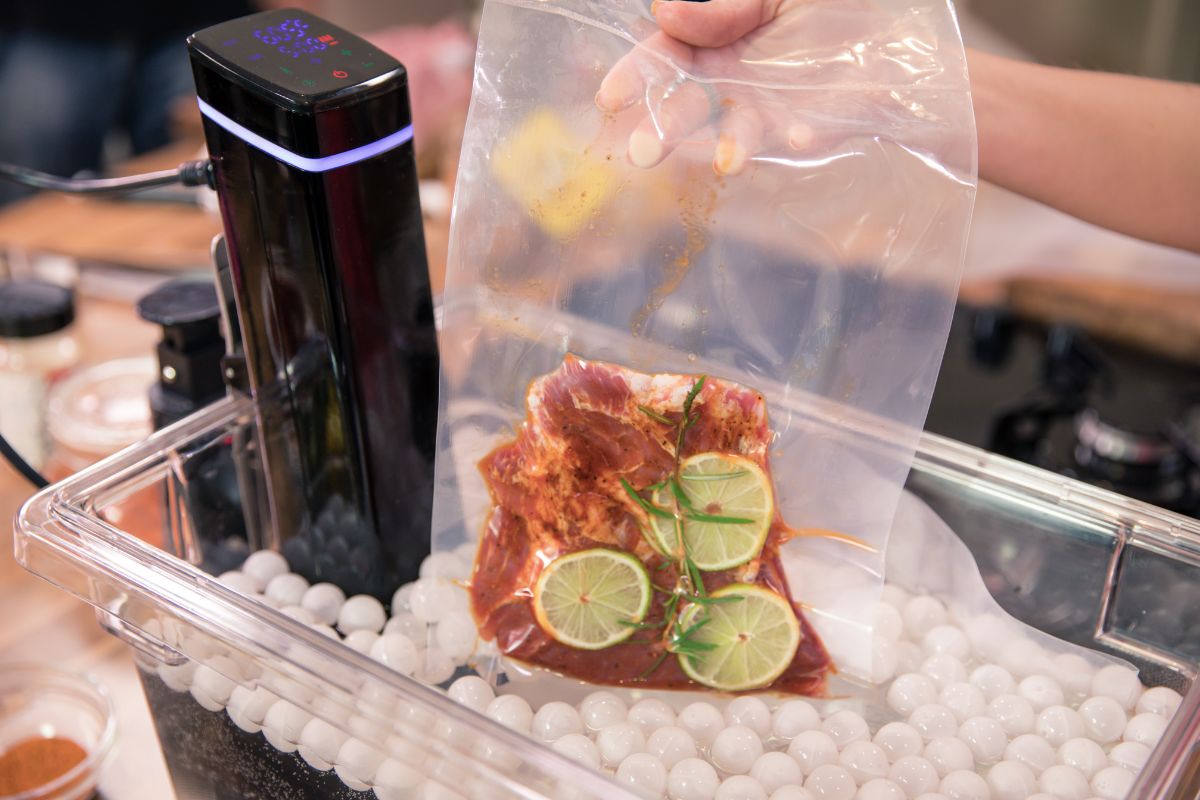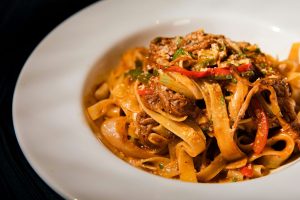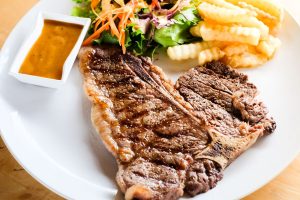Sous vide is not new. But it’s finally everywhere. And there’s a reason why chefs, hotel kitchens, and even caterers are switching over. Actually, there are a lot of reasons.
Let’s start with the basics: what is sous vide?
Sous vide (French for “under vacuum”) is a cooking method where food is vacuum-sealed in a bag, then cooked in a water bath at a precise, consistent temperature. That’s the entire idea. Control the temperature. Hold it for the right amount of time. Done.
But here’s why that matters: when you use the sous vide method, you eliminate the usual unpredictability that comes from pan frying, oven roasting, or grilling. The margin for error gets smaller. A steak gets cooked edge-to-edge at the exact same doneness. Chicken stays juicy. Vegetables don’t turn mushy or stay raw in the middle. The water does all the work, holding the temperature right where it needs to be until the food is ready.
Now let’s move from “the what” to “the why”.
Why the Food Industry Is Turning to Sous Vide
In the food industry, especially in commercial kitchens, consistency is everything. When you’re serving 100+ covers a night, or preparing meals for a hotel, hospital, or airline, you don’t have time to guess. You need results you can count on.
The sous vide cooking method gives you that. Every time.
Hotels, for example, rely on batch cooking. But batch cooking with traditional methods often means drying out proteins or undercooking something and having to start over. With sous vide, that’s not a concern. You set your temp, seal your food, and let the water bath take care of the rest.
It’s the same in catering. When you’re feeding hundreds at a wedding or event, the last thing you want is overcooked salmon or uneven chicken. Sous vide fixes that. You cook everything to temp ahead of time, chill it, then reheat with a quick sear or finishing step. Quality stays high. Waste stays low.
That’s why so many restaurants are moving to sous vide. It’s not just a trend. It’s a system upgrade.
The Sous Vide Method Is Built for Efficiency
Restaurants and commercial kitchens don’t just care about food quality – they care about time, labor, and profit margins.
Sous vide helps on all three fronts.
You can prep in advance. Vacuum-sealed proteins can be cooked, chilled, and stored safely for days. That means less work during service, fewer mistakes during a rush, and fewer people needed on the line.
From a food safety standpoint, sous vide is also easier to control. Cooking food in vacuum-sealed bags at safe temperatures and chilling them properly after reduces bacterial growth. You don’t have to guess if something hit 165°F – your immersion circulator keeps it there the whole time. USDA guidelines for pasteurization at lower temperatures are followed precisely.
And you don’t need to be a Michelin chef to do it right. The process is repeatable. Staff can be trained quickly. There’s less need to rely on “feel” and more opportunity to build a reliable workflow.
What Happens If You Skip Precision?
When you’re not using sous vide, you’re back to managing dozens of variables. Heat fluctuations. Human error. Timing problems. Food can go from undercooked to overcooked in seconds, especially with thick cuts of meat or delicate proteins.
A chicken breast in a pan is either pink in the middle or bone dry by the time it’s “safe.” In sous vide, it stays juicy, never goes past the target temp, and holds that temp for long enough to kill pathogens.
The same goes for fish, eggs, vegetables, pork, and even desserts. Cooking them at a precisely controlled temperature lets you avoid guesswork and waste.
Common Mistakes in Sous Vide Cooking (And How the Industry Avoids Them)
Even with a precise method, mistakes happen. One of the biggest? Not sealing the bags properly. Air in the bag means heat transfer slows down. Another mistake is setting the wrong temperature or not using a calibrated device.
Overcrowding the water bath can also cause issues. Water needs to circulate freely to maintain an even temperature around all the bags.
But in commercial kitchens that partner with a sous vide food company or use high-end equipment, those problems are already accounted for. That’s why pre-cooked, sous vide products are exploding in popularity. They remove every variable from the process. What shows up is already cooked perfectly and ready to finish.
The Benefits of Partnering with a Sous Vide Company Like Cuisine Solutions
Here’s what changes when a chef partners with a sous vide company like Cuisine Solutions.
You stop worrying about prep, doneness, or staffing gaps. You get premium proteins – already cooked, vacuum sealed, and ready to finish – delivered to your kitchen. That means a sous chef doesn’t need to babysit the line, and your food stays consistent whether it’s Monday or Saturday night.
But it’s not just about convenience. Cuisine Solutions works with Michelin-star chefs and food scientists to build recipes that meet exacting standards. So, the food isn’t just pre-cooked – it’s cooked the right way. Sous vide done at scale, without losing quality.
This kind of partnership gives chefs flexibility. They can order in bulk, manage food costs better, and still serve dishes that feel like they were cooked to order. And because the food is vacuum-sealed, shelf life extends dramatically, reducing spoilage and losses.
Sous Vide Isn’t Just for High-End Restaurants
Fast casual chains are using it too. Coffee shops. Airport lounges. Cruise lines. Anyone who needs to serve food fast without giving up quality is turning to sous vide.
Even in institutions like schools and hospitals, sous vide is showing up more. It lets them hit food safety targets and nutrition standards with less labor and less waste. And reheating is simple. Because the texture and moisture retention are locked in, food holds up during hot holding or service windows.
The technology also supports dietary restrictions better. You can prepare low-sodium meals, allergen-safe dishes, or consistent portions for calorie control – all with less hands-on cooking.
Final Word
The food industry doesn’t adopt new methods lightly. There’s too much at stake. Cost, quality, safety, speed. But sous vide checks every box.
It answers the question, “How do we serve better food with fewer errors?” And it solves it in a way that scales. Whether you’re running a 20-seat restaurant or a 2,000-meal-a-day commissary, the sous vide method simplifies everything.
Controlled cooking. Reduced waste. High consistency. Better food.
That’s why it’s taking over.










